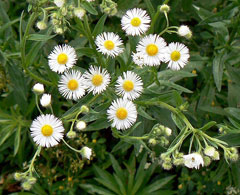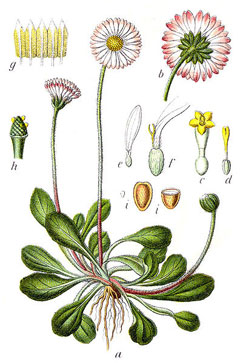 |
|
http://commons.wikimedia.org/wiki/File:Bellis_perennis_Sturm9.jpg |
 |
| http://commons.wikimedia.org/wiki/User:MONGO |
Translate this page:
Summary
Bloom Color: Pink, White.
Main Bloom Time: Early summer, Late spring. Form: Rounded.
Physical Characteristics

 Bellis perennis is an evergreen Perennial growing to 0.2 m (0ft 8in) by 0.2 m (0ft 8in) at a medium rate.
Bellis perennis is an evergreen Perennial growing to 0.2 m (0ft 8in) by 0.2 m (0ft 8in) at a medium rate.
See above for USDA hardiness. It is hardy to UK zone 4 and is not frost tender. It is in leaf all year, in flower all year, and the seeds ripen from May to October. The species is hermaphrodite (has both male and female organs) and is pollinated by Bees, flies, beetles. The plant is self-fertile.
Suitable for: light (sandy), medium (loamy) and heavy (clay) soils and prefers well-drained soil. Suitable pH: mildly acid, neutral and basic (mildly alkaline) soils. It can grow in semi-shade (light woodland) or no shade. It prefers moist soil.
UK Hardiness Map
US Hardiness Map
Synonyms
Plant Habitats
Lawn; Meadow;
Edible Uses
Edible Parts: Flowers Leaves
Edible Uses:
Leaves - raw or cooked[2, 7, 52, 115]. The flavour is somewhat acrid[4]. A pleasant sour flavour according to another report[238] whilst a third says that they are mild and agreeable and are used in salads[217]. The daisy is occasionally used as a potherb[183]. Flower buds and petals - raw[144, 183]. Eaten in sandwiches, soups and salads[183].
References More on Edible Uses
Medicinal Uses
Plants For A Future can not take any responsibility for any adverse effects from the use of plants. Always seek advice from a professional before using a plant medicinally.
Anodyne Antidiarrhoeal Antispasmodic Antitussive Cancer Demulcent Digestive Eczema
Emollient Expectorant Laxative Ophthalmic Purgative Tonic
Daisies are a popular domestic remedy with a wide range of applications[7]. They are a traditional wound herb[238] and are also said to be especially useful in treating delicate and listless children[7]. Recent research (1994) has been looking at the possibility of using the plant in HIV therapy[238]. The herb is mildly anodyne, antispasmodic, antitussive, demulcent, digestive, emollient, expectorant, laxative, ophthalmic, purgative and tonic[7, 9, 21]. The fresh or dried flowering heads are normally used[9]. An infusion is used in the treatment of catarrh, rheumatism, arthritis, liver and kidney disorders, as a blood purifier etc[9]. The daisy once had a great reputation as a cure for fresh wounds[4]. An ointment made from the leaves is applied externally to wounds, bruises etc[4, 232] whilst a distilled water is used internally to treat inflammatory disorders of the liver[4]. Chewing the fresh leaves is said to be a cure for mouth ulcers[244]. Daisies also have a reputation for effectiveness in treating breast cancers[7]. The flowers and leaves are normally used fresh in decoctions, ointments and poultices[238]. A strong decoction of the roots has been recommended for the treatment of scorbutic complaints and eczema, though it needs to be taken for some time before its effect becomes obvious[244]. A mild decoction may ease complaints of the respiratory tract, rheumatic pains and painful or heavy menstruation[244]. The plant, harvested when in flower, is used as a homeopathic remedy[232]. Its use is especially indicated in the treatment of bruising etc[232].
References More on Medicinal Uses
The Bookshop: Edible Plant Books
Our Latest books on Perennial Plants For Food Forests and Permaculture Gardens in paperback or digital formats.

Edible Tropical Plants
Food Forest Plants for Hotter Conditions: 250+ Plants For Tropical Food Forests & Permaculture Gardens.
More

Edible Temperate Plants
Plants for Your Food Forest: 500 Plants for Temperate Food Forests & Permaculture Gardens.
More

More Books
PFAF have eight books available in paperback and digital formats. Browse the shop for more information.
Shop Now
Other Uses
Repellent
An insect repellent spray can be made from an infusion of the leaves[57]. Daisies have traditionally been used for making daisy chains in children's games.
Special Uses
Food Forest
References More on Other Uses
Cultivation details
Landscape Uses:Alpine garden, Border, Container, Ground cover, Rock garden. Succeeds in most well-drained soils in sun or semi-shade[188, 200]. The daisy is commonly found growing in many lawns, some varieties have been developed for the flower garden[1]. It is a good plant for the spring meadow[24]. The plants have a very long flowering season, they will even produce a few flowers in the middle of mild winters[K]. Special Features:
Edible, Not North American native, Naturalizing, Attracts butterflies, Suitable for dried flowers. The plant is heat tolerant in zones 8 through 1. (Plant Hardiness Zones show how well plants withstand cold winter temperatures.
Plant Heat Zones show when plants would start suffering from the heat.
The Plant Heat Zone map is based on the number of "heat days" experienced in a given area where the temperature climbs to over 86 degrees F (30°C).
At this temperature, many plants begin to suffer physiological damage. Heat Zones range from 1 (no heat days) to 12 (210 or more heat days).
For example Heat Zone. 11-1 indicates that the plant is heat tolerant in zones 11 through 1.) For polyculture design as well as the above-ground architecture (form - tree, shrub etc. and size shown above) information on the habit and root pattern is also useful and given here if available. The plant growth habit is a clumper with limited spread [1-2]. The root pattern is fibrous dividing into a large number of fine roots [1-2]. The root pattern is rhizomatous with underground stems sending roots and shoots along their length [1-2].
References Carbon Farming Information and Carbon Sequestration Information
Temperature Converter
Type a value in the Celsius field to convert the value to Fahrenheit:
Fahrenheit:
The PFAF Bookshop
Plants For A Future have a number of books available in paperback and digital form. Book titles include Edible Plants, Edible Perennials, Edible Trees,Edible Shrubs, Woodland Gardening, and Temperate Food Forest Plants. Our new book is Food Forest Plants For Hotter Conditions (Tropical and Sub-Tropical).
Shop Now
Plant Propagation
Seed - sow as soon as the seed is ripe in June. When they are large enough to handle, prick the seedlings out into individual pots and plant them out in late summer[200]. Division after flowering[200]. Very easy, it can be done at almost any time of the year, though spring and early summer are best[K]. The divisions can be planted straight out into their permanent positions.
Other Names
If available other names are mentioned here
Common daisy, lawn daisy, English daisy, bruisewort, woundwort.
Native Range
TEMPERATE ASIA: Armenia, Azerbaijan, Ciscaucasia, Cyprus, Georgia, Iran (north & west), Iraq, Israel, Jordan, Lebanon, Russian Federation-Ciscaucasia, Syria, Turkey,Afghanistan. EUROPE: Denmark, United Kingdom (U.K.), Ireland, Sweden, Austria, Belgium, Switzerland, Czech Republic, Germany, Hungary, Netherlands, Poland, Slovakia, Russian Federation-European part, European part, Belarus, Moldova, Ukraine (incl. Krym), Albania, Bulgaria, Bosnia and Herzegovina, Greece (incl. Crete), Croatia, Italy (incl. Sardinia, Sicily), North Macedonia, Montenegro, Romania, Serbia, Slovenia, Spain (incl. Baleares), France (incl. Corsica), Portugal, AFRICA: Morocco.
Weed Potential
Right plant wrong place. We are currently updating this section.
Please note that a plant may be invasive in one area but may not in your area so it's worth checking.
This plant can be weedy or invasive. Though invasive, the species is still considered a valuable ground cover in certain garden settings (e.g., as part of English or cottage inspired gardens, as well as spring meadows where low growth and some color is desired in parallel with minimal care and maintenance while helping to crowd out noxious weeds once established and naturalised.
Conservation Status
IUCN Red List of Threatened Plants Status : This taxon has not yet been assessed.

Growth: S = slow M = medium F = fast. Soil: L = light (sandy) M = medium H = heavy (clay). pH: A = acid N = neutral B = basic (alkaline). Shade: F = full shade S = semi-shade N = no shade. Moisture: D = dry M = Moist We = wet Wa = water.
Now available:
Food Forest Plants for Mediterranean Conditions
350+ Perennial Plants For Mediterranean and Drier Food Forests and Permaculture Gardens.
[Paperback and eBook]
This is the third in Plants For A Future's series of plant guides for food forests tailored to
specific climate zones. Following volumes on temperate and tropical ecosystems, this book focuses
on species suited to Mediterranean conditions—regions with hot, dry summers and cool, wet winters,
often facing the added challenge of climate change.
Read More
Expert comment
Author
L.
Botanical References
17200
Links / References
For a list of references used on this page please go here
Readers comment
© 2010, Plants For A Future. Plants For A Future is a charitable company limited by guarantee, registered in England and Wales. Charity No. 1057719, Company No. 3204567.